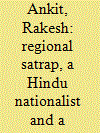|
|
|
Sort Order |
|
|
|
Items / Page
|
|
|
|
|
|
|
| Srl | Item |
| 1 |
ID:
146664


|
|
|
|
|
| Summary/Abstract |
This article is about forest governance in India and presents a unique, federalism perspective on the subject. While forest governance and federalism have both been deeply researched in academic scholarship, there is little work that deals with the linkages between the two. In addressing this gap in scholarship, the article explains forest federalism through a focus on three dimensions. The first is the Constitutional construct of the forest sector, and its interpretations through legislative provisions. The second is the administrative, financial and institutional linkages between the Centre and States, including the influence of the Indian Forest Service. The third looks at vertical and horizontal asymmetries in the sector, and the ways in which these relate to administrative and resource concerns in federal functioning. The paper concludes with a reflection on the relevance of forest federalism in on-going international environmental debates.
|
|
|
|
|
|
|
|
|
|
|
|
|
|
|
|
| 2 |
ID:
146666


|
|
|
|
|
| Summary/Abstract |
DP Mishra, chief minister of Madhya Pradesh from 1963 to 1967 and twice minister in Central Provinces and Berar (1937–1939, 1946–1950), was a key figure in Congress politics and provincial governance from the pre- to the post-independence period in India. Mishra was a noted Patel acolyte and a vocal critic of Nehru. A Brahmin leader, he identified with an elite-based Hindu politics of caste and community. He was also an efficient administrator and his career peaked in 1966–1967 when he acted as a counsellor to Prime Minister Indira Gandhi. In this paper, I argue that his political life is an important prism through which to view Congress politics, its High Command culture, its character in provinces/states and its continuities with the colonial state in governance.
|
|
|
|
|
|
|
|
|
|
|
|
|
|
|
|
| 3 |
ID:
146668


|
|
|
|
|
| Summary/Abstract |
This paper analyses opinions of political self-sacrifice amongst Tibetan refugees, and explores their meaning for wider debates on the evolving relationship between religion and politics in the Tibetan national struggle. This is a particularly pertinent question at present, given the recent prevalence of self-immolation in Tibet and connected debates about whether such protests are religious or political issues. Does the increase of self-sacrificial political methodology indicate a secularisation process of the Tibetan movement, as some have suggested, or is it simply reflective of the natural fluidity of religion's political influence? This paper supports the latter position and seeks to explore the nature of this dynamic relationship, including the positioning within it of the Dalai Lama.
|
|
|
|
|
|
|
|
|
|
|
|
|
|
|
|
| 4 |
ID:
146667


|
|
|
|
|
| Summary/Abstract |
Assistance to India from Japan under its Official Development Aid (ODA) programme has been particularly important for infrastructure development. India has been the single largest recipient of Japanese ODA since 2003–2004. Most of it has been directed towards long-term participation in infrastructure, much of which comes from the enormous demand. With the Indian Prime Minister’s visit on 3 August 2014, Japan committed to invest $35 billion in different sectors focusing on infrastructure in the coming five years. This investment will boost India’s infrastructure sector. Poor infrastructure is a constraint to sustaining India’s high and inclusive growth rate. One major bottleneck in infrastructure development is infrastructure financing (along with many others, such as land acquisition, environment clearance, and cost-time overruns). In this context, the paper explores the impact of Japanese ODA on the infrastructure sector in India, the trends and priority sectors for Japanese ODA, and the problems and challenges of this developing relationship.
|
|
|
|
|
|
|
|
|
|
|
|
|
|
|
|
| 5 |
ID:
146665


|
|
|
|
|
| Summary/Abstract |
The end of the ethnic conflict in Sri Lanka in 2009 generated widespread expectations of a period of sustained economic growth, building on the achievements of the liberalization reforms over the three previous decades. However, recent developments have dampened that optimism, rekindling fears that Sri Lanka's tale of missed opportunities may continue. The analysis in this paper suggests that the return to the failed past policies of inward-oriented development strategies offers no viable solutions for the economic problems confronting Sri Lanka.
|
|
|
|
|
|
|
|
|
|
|
|
|
|
|
|
|
|
|
|
|